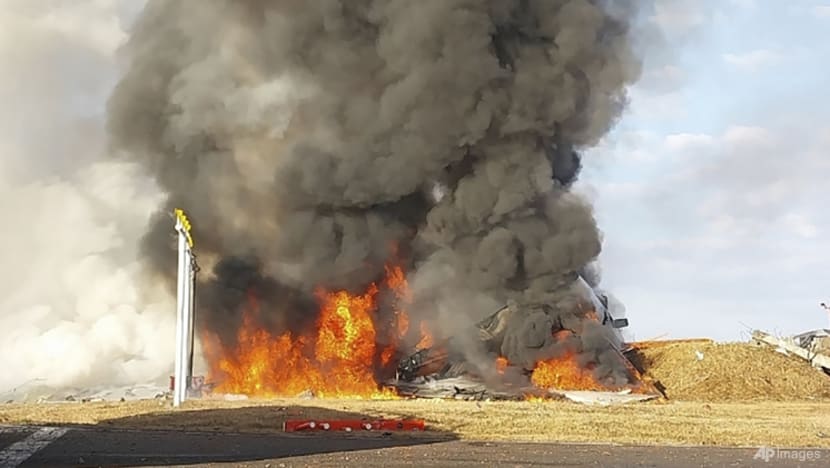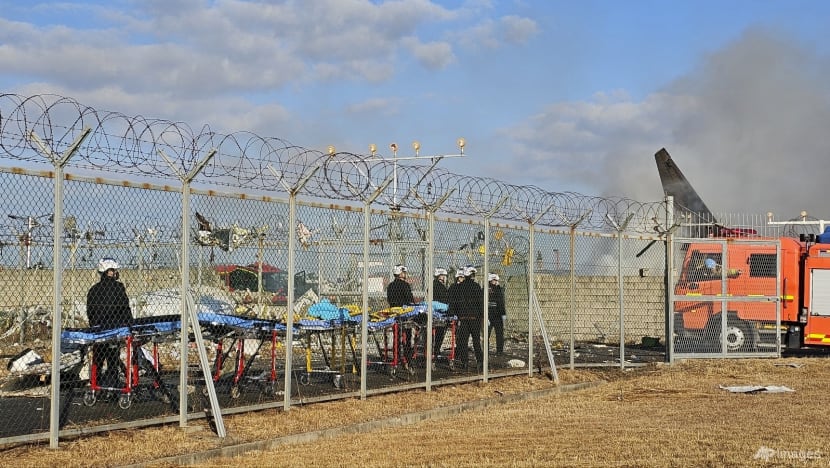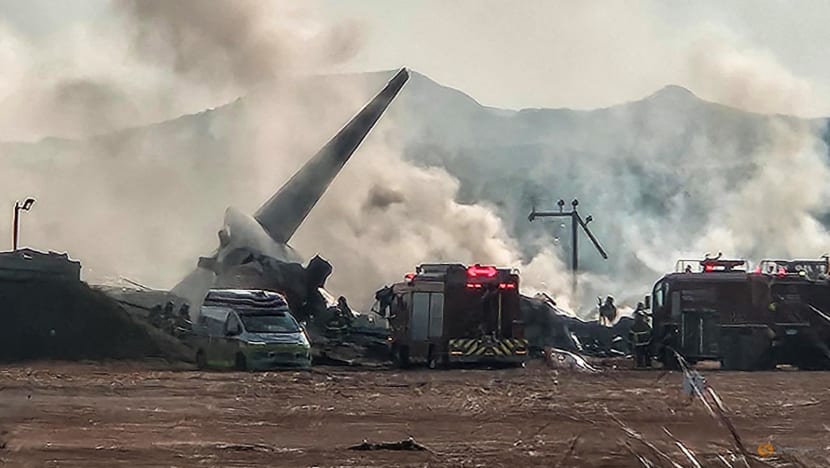Advertisement
Jeju Air flight 7C2216, carrying 175 passengers and six crew members on a flight from Bangkok, was landing at Muan International Airport when it crashed.

A Jeju Air plane in flames at Muan International Airport in South Korea, Dec 29, 2024. (Photo: Muan Fire Station via AP)
29 Dec 2024 09:03AM (Updated: 29 Dec 2024 08:00PM)
MUAN COUNTY, South Korea: At least 176 people were killed when an airliner landed without wheels, veering off the runway and erupting in a fireball as it slammed into a wall at South Korea’s Muan International Airport on Sunday (Dec 29), Yonhap news agency reported.
Jeju Air flight 7C2216, arriving from the Thai capital Bangkok with 181 people on board, was attempting to land shortly after 9am (8am, Singapore time) at the airport in the south of the country, South Korea’s transport ministry said.
It is the deadliest air accident involving a South Korean airline in nearly three decades, according to ministry data.
The twin-engine Boeing 737-800 can be seen in video from local media skidding down the runway with no apparent landing gear before slamming into a wall in an explosion of flame and debris. Other photos showed smoke and fire engulfing parts of the plane.
Two crew members, a man and a woman, were rescued from the tail section of the burning plane, Muan fire chief Lee Jung-hyun told a briefing. The fire was extinguished as of 1pm, Lee said.
“Only the tail part retains a little bit of shape, and the rest of (the plane) looks almost impossible to recognise,” he said.
Authorities have switched from rescue to recovery operations and because of the force of the impact, are searching nearby areas for bodies possibly thrown from the plane, Lee added.
The two crew members were being treated at hospitals with medium to severe injuries, said the head of the local public health centre.
“MY LAST WORDS”
Hours after the crash, family members gathered in the airport’s arrival area, some crying and hugging as Red Cross volunteers handed out blankets.
Families screamed and wept loudly as a medic announced the names of 22 victims identified by their fingerprints.
Papers were circulated for families to write down their contact details.
One relative stood at a microphone to ask for more information from authorities. “My older brother died and I don’t know what’s going on,” he said. “I don’t know.”
Another asked journalists not to film. “We are not monkeys in a zoo,” he said. “We are the bereaved families.”
Mortuary vehicles lined up outside to take bodies away, and authorities said a temporary morgue had been established.
The crash site smelled of aviation fuel and blood, according to Reuters witnesses, and workers in protective suits and masks combed the area while soldiers searched through bushes.
Authorities had worked to rescue people in the tail section, an airport official told Reuters shortly after the crash.
The crash is the worst by any South Korean airline since a 1997 Korean Air crash in Guam that killed more than 200 people, according to transportation ministry data.
Investigators are looking into bird strikes and weather conditions as possible factors, Lee said. Yonhap cited airport authorities as saying a bird strike may have caused the landing gear to malfunction.
The control tower issued a bird strike warning and shortly afterwards the pilots declared mayday, a transport ministry official said, without specifying whether the flight said it struck any birds.
Soon after the mayday call the aircraft made its ill-fated attempt to land, the official said.
A passenger texted a relative to say a bird was stuck in the wing, the News1 agency reported. The person’s final message was, “Should I say my last words?”
The passengers included two Thai nationals and the rest are believed to be South Koreans, according to the transportation ministry.

The Boeing 737-800 jet was manufactured in 2009, the transport ministry said.
The two CFM56-7B26 engines were manufactured by CFM International, a joint venture between GE Aerospace and France’s Safran, the transport ministry said.
A CFM spokesperson said: “We are deeply saddened by the loss of Jeju Air flight 2216. We extend our heartfelt sympathies to the families and loved ones of those on board.”
BEREAVED ARE TOP PRIORITY
Jeju Air CEO Kim E-bae apologised for the accident, bowing deeply during a televised briefing.
He said the cause of the crash was still unknown, that the aircraft had no record of accidents and there were no early signs of malfunction.
The airline will cooperate with investigators and make supporting the bereaved its top priority, Kim said.
No abnormal conditions were reported when the aircraft left Bangkok’s Suvarnabhumi Airport, said Kerati Kijmanawat, president of Airports of Thailand.
It is the first fatal flight for Jeju Air, a low-cost airline founded in 2005 that ranks behind only Korean Air Lines and Asiana Airlines in terms of the number of passengers in South Korea.
The accident happened only three weeks after it started regular flights from Muan to Bangkok and other Asian cities on Dec 8.
Muan International is one of South Korea’s smallest airports but it has seen the number of international passengers jump nearly 20 times to 310,702 from January to November this year, from the same period in 2022, according to government data.
Boeing said in an emailed statement: “We are in contact with Jeju Air regarding flight 2216 and stand ready to support them. We extend our deepest condolences to the families who lost loved ones, and our thoughts remain with the passengers and crew.”
The US Federal Aviation Administration did not immediately respond to a request for comment.
All domestic and international flights at Muan airport had been cancelled, Yonhap reported.

South Korean’s Acting President Choi Sang-mok, named interim leader of the country on Friday in an ongoing political crisis, arrived at the scene of the accident and said the government was putting all its resources into dealing with the crash.
Suspended President Yoon Suk Yeol said in a post on Facebook that he sent his “deepest condolences” to the families of those who died in the crash.
“I will be with the people to overcome this difficult situation as soon as possible,” he added.
Two Thai women were on the plane, aged 22 and 45, Thai government spokesperson Jirayu Houngsub said, adding that details were still being verified.
Thai Prime Minister Paetongtarn Shinawatra sent condolences to the families of the dead and injured in a post on X, saying she had instructed the foreign ministry to provide assistance.
The ministry said in a statement it was in touch with the South Korean authorities.

This is the first fatal accident in the history of Jeju Air.
On Aug 12, 2007, a Bombardier Q400 operated by Jeju Air carrying 74 passengers came off the runway due to strong winds at the southern Busan-Gimhae airport, resulting in a dozen injuries.
South Korea’s aviation industry has a solid track record for safety, experts say.
Source: Agencies/gr/mi/nh
